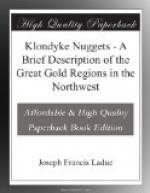“The passage through is made in about three minutes, or at the rate of about 12-1/2 miles an hour. If the boat is kept clear of the sides there is not much danger in high water; but in low water there is a rock in the middle of the channel, near the upper end of the canon, that renders the passage more difficult. I did not see this rock myself, but got my information from some miners I met in the interior, who described it as being about 150 yards down from the head and a little to the west of the middle of the channel. In low water it barely projects above the surface. When I passed through there was no indication of it, either from the bank above or from the boat.
“The distance from the head to the foot of the canon is five-eighths of a mile. There is a basin about midway in it about 150 yards in diameter. This basin is circular in form, with steep sloping sides about 100 feet high. The lower part of the canon is much rougher to run through than the upper part, the fall being apparently much greater. The sides are generally perpendicular, about 80 to 100 feet high, and consist of basalt, in some places showing hexagonal columns.
“The White Horse Rapids are about three-eighths of a mile long. They are the most dangerous rapids on the river, and are never run through in boats except by accident. They are confined by low basaltic banks, which, at the foot, suddenly close in and make the channel about 30 yards wide. It is here the danger lies, as there is a sudden drop and the water rashes through at a tremendous rate, leaping and seething like a cataract. The miners have constructed a portage road on the west side, and put down rollways in some places on which to shove their boats over. They have also made some windlasses with which to haul their boats up hill, notably one at the foot of the canon. This roadway and windlasses must have cost them many hours of hard labor. Should it ever be necessary, a tramway could be built past the canon on the east side with no great difficulty. With the exception of the Five Finger Rapids these appear to be the only serious rapids on the whole length of the river.
“Five Finger Rapids are formed by several islands standing in the channel and backing up the water so much as to raise it about a foot, causing a swell below for a few yards. The islands are composed of conglomerate rock, similar to the cliffs on each side of the river, whence one would infer that there has been a fall here in past ages. For about two miles below the rapids there is a pretty swift current, but not enough to prevent the ascent of a steamboat of moderate power, and the rapids themselves I do not think would present any serious obstacle to the ascent of a good boat. In very high water warping might be required. Six miles below these rapids are what are known as ’Rink Rapids,’ This is simply a barrier of rocks, which extends from the westerly side of the river about half way across. Over this barrier there is a ripple which would offer no great obstacle to the descent of a good canoe. On the easterly sides there is no ripple, and the current is smooth and the water apparently deep. I tried with a 6 foot paddle, but could not reach the bottom.




